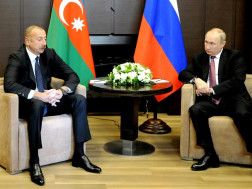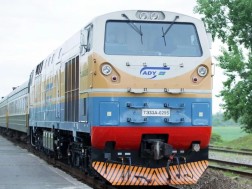The repair and expansion work on the Baku-Tbilisi-Kars (BTK) railway line, a critical segment of the Middle Corridor, is nearing completion. Notably, 95% of the repair, reconstruction, and construction work on the 183 km section of the railway line that traverses Georgia"s complex geographic terrain has been successfully completed. The primary goal of modernizing this railway line is to enhance the competitiveness of the Middle Corridor and attract a significant portion of cargo to the BTK
route.
The BTK railway line plays a vital role in transporting goods from China and Central Asian countries to Europe in the shortest possible time. Facilitating the faster movement of goods from Asia to Europe via Azerbaijan through streamlined operations further emphasizes the BTK"s significance within the regional transportation network.
To meet the increasing demand for cargo transport, comprehensive repair and expansion work commenced in 2023, with final completion efforts currently underway.
A joint review of the project was conducted on 2 March by the heads of the Azerbaijani, Georgian, and Turkish railway administrations, Rovshan Rustamov, David Peradze, and Veysi Kurt, as well as discussions were made on site to ensure the project"s timely completion according to the
schedule. Both Turkish and Georgian heads of railway administrations have expressed their satisfaction with the rapid progress of the concluding works.
Mr. Veysi Kurt, the Director General of the State Railways of the Republic of Turkey, emphasized, "Today, we witness the culmination of works executed at a very high level, and soon, we will commence cargo operations".
Rovshan Rustamov, Azerbaijan Railways Chairman, stated that the main tasks in the Marabda-Kartsakhi section, known for its challenging terrain, forests, and mountains, have been completed. These tasks included strengthening the railway infrastructure, increasing the transportation
capacity, and ensuring safety. Initiated on the directives of President Ilham Aliyev, these efforts are set to boost the cargo transport capacity of the BTK to 5 million tons annually. Such an enhancement will elevate the BTK's status, making it a key component of the Middle Corridor. The growing need to augment the flow of goods from Central and broader Asia towards the West, and the reverse, reflects both a current demand and a new global trend. Azerbaijan Railways
(ADY) stands prepared to embrace these challenges, ensuring its competitive stance in international cargo transportation through the upgraded BTK railway line," Rustamov added.
The BTK project consists of five parts, three of which have been completed and officially documented by the Georgian Government.
The first part of the BTK project, covering the 29.2 km Marabda-Tetriskaro railway line, included three railway stations, two half-stations, four passenger platforms, and 38 km of contact network lines. All works, including the installation and activation of signaling, centralization, and
blocking devices, cabling of switches, and other expansion works, have been completed, with official documentation obtained.
For the second part, the 49.7 km Tetriskaro-Tsalka railway line, all works at three railway stations, three passenger platforms, and two half-stations, as well as the 5.9 km snow protection fences, have been completed. This includes the installation and activation of signaling, centralization, and
blocking devices, with official documentation for completion obtained.
The third part, the 74.1 km Tsalka-Akhalkalaki railway line, has seen the completion of works at four railway stations, three half-stations, and four passenger platforms. Currently, repair works in four snow protection galleries (tunnels) are ongoing, with all planned works expected to be finalized in March-April of the current year.
The fourth part, involving the reconstruction of the 27 km Akhalkalaki-Kartsakhi main railway line, including the repair of a railway station and passenger platforms, among other tasks, has been completed. This section also has official documentation for completion.
Additionally, the construction of the 110-hectare Akhalkalaki complex represents the fifth part of the project. This phase included the repair of an overpass, two aqueducts, four bridges, two road crossings, and two underground pedestrian crossings, the construction of snow protection walls, the installation of 17.9 km of new contact network, the refurbishment of a half-station, the construction of 48 km of internal station roads, 3.9 km of automotive roads, etc. Modern technologies and equipment from European manufacturers were used in the construction of the complex. Currently, the supply of the equipment and final completion works are underway.
BTK railway line (with some works conducted at altitudes up to 2400 m above sea level) and harsh winter weather conditions (temperatures dropping to -30°C), repair and restoration works have not been hindered. It is worth noting that during the autumn-winter season, when snowy weather conditions often lead to the closure of roads, railway transport becomes the only means of communication between the region and central areas, playing a crucial role.
Azerbaijan Railways Chairman Rovshan Rustamov stated that April 2024 is set as a deadline to finish the project.
“All resources have been mobilized to complete the remaining works by April. Following the project"s full completion, a joint venture should be established between Azerbaijan and Georgia to efficiently manage operations on the BTK and attract new cargo. Respective work has already
begun, and the establishment of a joint venture is expected soon,”- Rustamov said.
It should be noted that the modernization of the BTK railway line, one of the most important segments of the Middle Corridor, is being carried out directly under the instructions of the President of the Republic of Azerbaijan Ilham Aliyev. Thanks to the far-sighted policy of President Aliyev, the BTK railway line has rapidly increased its attractiveness within the international transport network, significantly boosting demand for cargo transport from the East to the West and vice versa.























